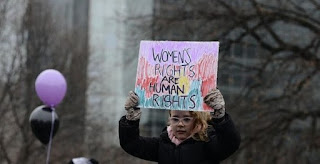 8 March 1857. In one of the most κεντÏικους streets of New York a multitude of λευκοντυμÎνων women…
8 March 1857. In one of the most κεντÏικους streets of New York a multitude of λευκοντυμÎνων women…
working in the textile factories do something very daring for the era and especially for their gender:
Protest to demand better working conditions and decent wages.
“Not in the inhuman work – Not the low wages” were the main slogans of the protest which can be suppressed immediately and brutally by the authorities, but he managed to be the most timeless landmark in the official history of women’s emancipation. Two years later, the women who participated in the mobilizations organized the first labor union for women, which laid the foundations of the feminist movement. The change had already begun, slowly but steadily without precedent, and without refund.
Until then, and for many years after, the woman’s right to equal work was at least fine print that αχνοφαίνονταν behind rules written by men for men. During the French revolution, which was preceded by the women of Paris were calling for “Liberty, Equality, Fraternity” in a similar demonstration at Versailles.
In 1908, a half century after the great events of that first 8 March, the streets of New York city would be flooded again than women. Their voices, the 15,000 number, rise, and demand for, once again, fewer working hours, better wages and the right to vote. This is the famous demonstration in which he sounded the symbolic slogan “Bread and Roses”. Where bread for economic security and roses a better quality of life.
The celebration of 8 March is a tribute to the struggles of most ordinary women of mankind, who with the courage and determination of their written history. For the first time was celebrated on 28 February 1909, on the initiative of the Socialist Party of the united states, while two years later he was established by the Socialist International. The German socialist Clara Zetkin was the one who raised the issue during the Second International, 1910 .
Turning point in the establishment of 8 March and the October Revolution of 1917 in Russia, after Vladimir Lenin, after intense urging of the feminist μπολσεβίκας Alexandra Kollontai, held as an official public holiday, which gave additional political background in the specific celebration.
However in the years that followed until the institutionalization of 1977 by the UN, the Day of the Woman had already acquired several additional aspects. For some, lost the strict political symbolism and acquired a commercial side, as the equivalent of Valentine’s day when men give gifts to women, as those arranging evening get-togethers with friends to celebrate the “independence”. In several parts of the world, however, where nothing is still given in terms of the kinds of rights of our sex, the real importance of the day to support the empowerment and equality of women remains pronounced, and, above all, authoritative.
It was less than 10 years since the police in the iranian capital was attacked, arrested, and led to the isolation of dozens of women who just made the “mistake” to organize a rally in Tehran for the celebration of this day.
Even more recently, the 2016 protesters in Καντίκιοϊ of Istanbul, where they had gathered to celebrate the international Day of the Woman, fled in order to avoid the rubber bullets Turkish police
International Women’s Day: The history of 8 March
—